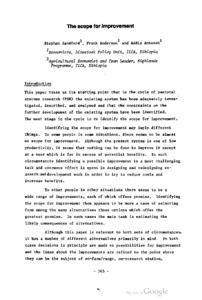The importance of wealth effects on pastoral production: A rapid method of wealth ranking
Discusses the importance of wealth differences among producers in traditional pastoral production systems, describing a rapid method, dependent on informants, for determining the wealth rank of producers within a given community in order to stratify a population of producers before sampling.
The scope for improvement
Discusses the need for identifying sociological and economic possibilities for improvement in pastoral production systems, mentioning the major steps involved, particularly, identification of potential improvements, prediction of their likely impact on net production & quality of life; prediction of the probability of adoption; and assessment of the rapidity with which the improvements will bear fruit.
The potential benefits and challenges of agricultural animal biotechnology to pastoralists
The livelihoods of pastoralists revolve around their indigenous livestock. Combining high
production with disease resistance using genetic engineering is a biotechnological intervention
hailed by some as a promising avenue to mitigate food insecurity and poverty. Considerable
human and financial resources have already been devoted to exploring this option. However, the
challenges are enormous. It is unlikely that such livestock would survive in the harsh ecosystems
The sedentarisation process of the Bahima in Uganda: an emic view
The traditional lifestyle of nomadic pastoralists is vanishing rapidly, because of human population growth which often leads to land scarcity or political pressure on pastoralists to settle. The sedentarisation of the Bahima pastoralists in Western Uganda started in the 1940s and is still going on. In this study former nomadic cattle keepers, who have settled with their families, were interviewed in order to document the decision to settle and the subsequent changes in the lifestyle of these people. All interviewees expressed their satisfaction with their sedentary life.
The productivity and potential of pastoral systems
Examines the productivity of East African pastoral systems in terms of animal protein & energy production, milk offtake and livestock production parameters such as calving percentage, calf mortality and herd structure; compares the productivity of East African pastoral systems to those of commercial ranches and to pastoral systems in other parts of the world.
The Kenyan rangeland ecological monitoring unit (KREMU)
Discusses the Kenya Rangeland Ecological Monitoring Unit (KREMU), mentioning its objectives, initial tasks related to identifying ecological units, testing survey methods, training of staff & designing appropriate computer programmes; describes the Unit's achievements, with emphasis on ecological surveys & censuses carried out within the framework of on-going ecological monitoring programmes; outlines problems encountered.
The productivity of small ruminants in the Maasai pastoral system, Kajiado District, Kenya. An introduction to current research
Describes the research approach adopted by an interdisciplinary ILCA team to study a pastoralist production system, summarizing the methodology & results of research on small ruminants' productivity in the Maasai pastoral system, and outlining dif. features of current smallstock research in Kenya; w. an analysis of flock productivity, mortality, animal nutrition & behaviour at the Elangata Wuas group ranch.
The linkages between land use change, land degradation and biodiversity across East Africa
Land use changes in East Africa have transformed land cover to farmlands, grazing lands, human settlements and urban centers at the expense of natural vegetation. These changes are associated with deforestation, biodiversity loss and land degradation. A synthesis of results of long term research by an interdisciplinary team reveals the linkages between land use change, biodiversity loss and land degradation. The results indicate that as native vegetation is lost, indigenous plant and animal biodiversity and plant cover are lost.
The role of abandoned pastoral settlements in the dynamics of African large herbivore communities
A number of studies have begun to show the large impact that pastoralism has on African savanna ecosystems. Here we look at the impact of abandoned settlements on the distribution of the large ungulates of Amboseli, Kenya.
Monthly dung counts show that all 9 species studied are attracted by settlements for up to a century after abandonment.








